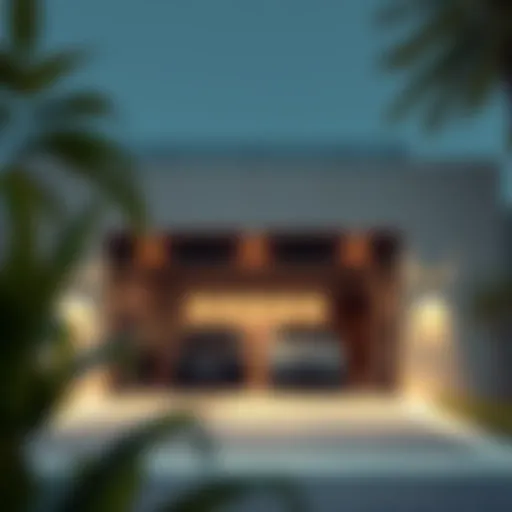Exploring the Red Line Metro Stations in Dubai
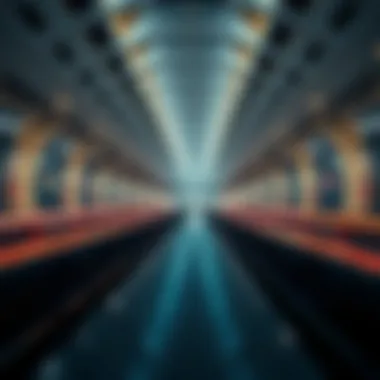
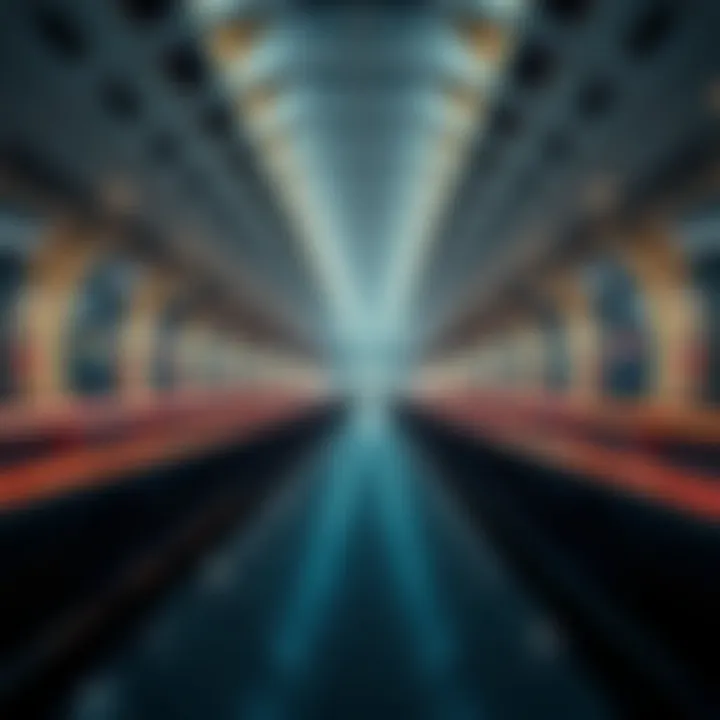
Intro
Dubai's Red Line Metro system has transformed the urban landscape of this bustling city, serving as a lifeline that connects people to their daily lives and ambitions. Its stations are not merely transit points; they embody the city’s aspirations and advancements in technology and architecture.
As we journey through this exploration, we'll delve into the operational framework of the Red Line, its architectural prowess, and the significant cultural and economic implications for neighborhoods that sit along its route. With a blend of modernity and functionality, these stations play a crucial role in the ebb and flow of Dubai’s populace.
Through this discourse, we aim to highlight key aspects, from the inception of the Red Line to the present day, while also peering into what the future holds, particularly regarding real estate opportunities near these hubs of metropolitan life.
Prolusion to the Red Line Metro
The Red Line Metro in Dubai stands as a pivotal element in the fabric of urban transit. It connects various regions of the city, facilitating seamless travel for residents and visitors alike. In this article, we will explore the significance of the Red Line Metro, shedding light on its historical development, operational details, and cultural significance.
Historical Context
The concept of a metro system in Dubai emerged from a vision to diversify the transport options in a rapidly growing city. Back in the late 1990s, the government aimed to address traffic congestion that plagued the city due to an influx of expatriates and tourists. Initially, plans were just blueprints, but by the early 2000s, those blueprints started to materialize into a feasible project. Construction began in 2006, and within a short timeframe, Dubai inaugurated the Red Line in 2010, marking a significant milestone in urban infrastructure. This development demonstrated the emirate’s commitment to enhancing public transport efficiency.
Development Timeline
The evolution of the Red Line has been marked by several key milestones:
- 2006: Groundbreaking ceremony initiated the construction of the metro system.
- 2009: Several sections of the Red Line were completed, showcasing modern engineering techniques and urban planning.
- 2010: The Red Line officially opened to the public, with 29 stations operating between Rashidiya and UAE Exchange, creating a vital link across the city.
- 2011-2020: Continued expansions and enhancements were made to improve operational efficiency and user experience. This included introducing advanced ticketing systems and integrating with other modes of public transportation.
The timeline not only reflects significant engineering accomplishments but also indicates how the Red Line has transformed Dubai's landscape into a more interconnected metropolis.
Overview of the Red Line
The Red Line of the Dubai Metro is more than just an efficient transit route; it’s a pivotal part of the urban ecosystem, deeply woven into the city's fabric. This section examines the geographical coverage and operational details of the Red Line, laying out its critical role in enhancing connectivity across Dubai. An understanding of this aspect of the Red Line shed light on the benefits it brings not only to daily commuters but also to developers and investors eyeing the flourishing real estate market and the socio-economic growth of the region.
Geographical Coverage
The Red Line sprawls across some of Dubai's most significant and vibrant areas, effectively linking the northern and southern reaches of the city. Running from Rashidiya in the east to UAE Exchange in the west, it spans approximately 52.1 kilometers and includes stations that grant access to popular neighborhoods, commercial hubs, and government offices. This coverage plays a critical role in dispelling traffic congestion by offering a viable alternative to car travel, thus contributing to a more sustainable form of urban mobility.
The stations along the Red Line serve industries, tourism, and residential areas, making them central to unlocking the potential of various districts. Key stops like Burj Khalifa/Dubai Mall, which is near one of the tallest buildings in the world, and Mall of the Emirates, known for its indoor ski slope, are crucial for attracting both tourists and local shoppers alike.
Interestingly, the introduction of various stations has prompted increased property values in nearby neighborhoods, further solidifying the Red Line as an investment magnet. This spatial relationship cannot be overlooked by property developers or investors looking to capitalize on the soaring demand for housing in prime locations.
Operational Details
Service Hours
Understanding the service hours of the Red Line brings clarity to its accessibility and user-friendliness. The metro operates from 5:00 AM to midnight on weekdays, and on weekends, these hours extend to 1:00 AM. This extensive scheduling means that the system caters to a variety of commuters, from early risers journeying to work to late-night revelers heading home. A key characteristic of the Red Line's service is the convenience it provides for shift workers and travelers arriving or departing late at night, making it a beneficial choice for diverse users.
However, the reliance on this metro as a primary mode of transport during off-peak hours does expose some vulnerabilities in service delivery, like potential overcrowding during peak travel times. While there are indeed benefits to having expansive service hours, it also poses challenges in regard to maintaining efficient frequency and cleanliness at all hours.
Frequency of Trains
The frequency of trains on the Red Line operates at an increasingly competitive rate, primarily running every 2 to 5 minutes during peak times and every 7 to 10 minutes off-peak. This rapid turnaround further enhances the metro's appeal, as it allows users to hop on and off with minimal waiting. One notable characteristic is the metro's ability to adapt its schedule during events or festivals, thus reflecting its responsiveness to commuter needs.
While this high frequency is a strong selling point, it does require intricate logistics and planning to manage train capacities during events or peak periods successfully. Users appreciate reliability and are often willing to engage in public transport if it means not overspending on travel or facing long waiting lines. With a finely tuned frequency that responds to both daily demands and special circumstances, the Red Line continues to play a crucial role in the interconnected web of Dubai’s public transportation.
Stations of the Red Line
The Red Line of the Dubai Metro is more than a mere transportation service; it serves as the veins of the city, connecting diverse districts and enabling seamless movement. Each station is uniquely designed, making them not just functional hubs, but landmarks that enhance the urban experience. This section delves into the intricacies of these stations, exploring their significance and the advantages they bring to both commuters and the surrounding areas.
List of Stations
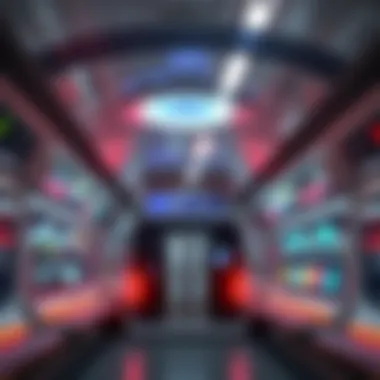

The Red Line spans across an impressive distance, boasting numerous stations that cater to various needs.
- UAE Exchange
- Rashidiya
- Airport Terminal 1
- Airport Terminal 2
- Deira City Centre
- Burj Khalifa/Dubai Mall
- Business Bay
- Union
- Jumeirah Lakes Towers
- Dubai Marina
Each of these locations serves as a bridge between residential, commercial, and recreational spaces, playing a crucial role in making daily commuting smoother for residents and tourists alike.
Architectural Features
Modern Design Aspects
One cannot overlook the modern design aspects of the Red Line stations. The structural philosophy prioritizes not only aesthetics but functionality as well. Large glass facades are a hallmark of most stations, basking in natural light while providing a panoramic view of the surroundings. This is particularly beneficial in a city like Dubai, where the skyline is a significant attraction.
One key characteristic of these modern designs is their focus on open spaces, which facilitates easier movement and enhances the user experience. Moreover, the incorporation of energy-efficient systems and smart technology showcases a forward-thinking approach to urban transport. The unique feature of certain stations, such as the Burj Khalifa/Dubai Mall stop, integrates directly with high-end shopping experiences, promoting foot traffic and commercial growth in its vicinity.
Materials Used
When discussing the materials used in constructing these stations, one can note a heavy reliance on steel and reinforced concrete. These materials are celebrated for their durability and ability to withstand the region’s harsh weather conditions. The design employs elements like ceramic tiles and aluminum cladding, which not only contribute to the aesthetic appeal but also ensure ease in maintenance, an essential factor in a bustling city.
The use of eco-friendly materials aligns with the broader sustainability goals of Dubai, making green choices more palatable for investors and developers. However, one unique feature that could be seen as a downside is the initial high costs associated with these materials. On the flip side, the long-term benefits they provide are hard to dispute, as they contribute to the structural integrity and longevity of the stations.
Accessibility Features
Accessibility is a critical aspect of the Red Line stations, ensuring all commuters can navigate the spaces comfortably. Features such as escalators, elevators, and tactile paving are implemented throughout the stations, promoting inclusivity. The design also adheres to international standards, which is invaluable for attracting a global audience.
For instance, facilities like designated seating areas for individuals with disabilities and clear signage in multiple languages enhance the overall commuter experience, fostering a sense of community.
In summary, the stations of the Red Line not only function as transit points but also contribute significantly to the urban landscape through innovative architecture and a focus on accessibility. This multi-faceted approach enhances both the economic and cultural fabric of Dubai.
Cultural Impact of the Red Line
The Red Line Metro is more than just a mode of transportation in Dubai; it serves as a vital thread weaving together diverse communities and enriching the cultural fabric of the city. By promoting accessibility, it fosters engagement and interaction among residents and visitors alike. This section aims to explore the significance of the Red Line beyond its operational capacity, shedding light on its role in community cohesion, artistic expression, and the overall urban landscape.
Community Engagement
The Red Line stations have become hubs of community activity, where people from various backgrounds converge. This diverse interaction contributes to social integration and a sense of belonging. Such stations as Burj Khalifa/Dubai Mall and Mall of the Emirates attract not only commuters but also tourists and local residents, creating a vibrant atmosphere.
- Event Spaces: Many stations are not merely transit points; they often serve as venues for local events and exhibitions. This engagement encourages cultural exchange and community bonding, creating an environment where individuals feel invested in their surroundings.
- Local Businesses: The access the Red Line provides plays a crucial role in supporting local economies. With foot traffic increasing, vendors and small business owners benefit from the diverse customer base. Cafes, boutiques, and craft stores flourish along the line, becoming essential parts of the cultural landscape.
In essence, through its community-oriented approach, the Red Line enhances social ties, dissolving barriers and establishing connections that enrich Dubai's identity.
Art Installations at Stations
Artistic expressions at Red Line Metro stations are not just decorative elements; they tell a story that reflects Dubai's growth and vision. Each station, with its unique artistic installations, contributes to a larger narrative about culture, identity, and innovation.
- Local Artists and Global Influence: The initiative to incorporate art into these stations demonstrates an appreciation for both local talent and international art forms. Installations often showcase the works of Emirati artists, intertwining cultural heritage with modernity. This blend not only elevates the stations' aesthetics but also highlights Dubai as a global cultural player, reinforcing its image as a dynamic metropolis.
- Interactive Installations: Some stations feature interactive art which engages commuters and encourages them to pause and reflect. Such art installations stimulate creativity and dialogue among travelers, adding a layer of depth to their commuting experience.
- Cultural Reflection: Art found in the stations often mirrors contemporary social issues, celebrating themes of unity, diversity, and the environment. By reflecting the evolving narrative of Dubai, these installations transform mundane transit spaces into platforms for cultural expression.
"Transportation is not just about movement; it's about connecting spaces, people, and ideas."
The artistic endeavors associated with the Red Line Metro not only beautify the urban landscape but also contribute immensely to public discourse, fostering a rich cultural ecosystem. This integration of art within transit not only enhances the aesthetic appeal but also deepens the connection between the city and its inhabitants, encouraging a reflective approach to urban life.
Economic Influence of the Red Line
The role of the Red Line Metro in shaping Dubai's economic landscape cannot be overstated. This rapid transit system not only provides a critical means of transportation but also significantly influences property values and business dynamics in its vicinity. Understanding this economic influence is vital for investors, real estate agents, and business developers as they navigate the opportunities and challenges presented by the metro's operation.
Property Value Appreciation

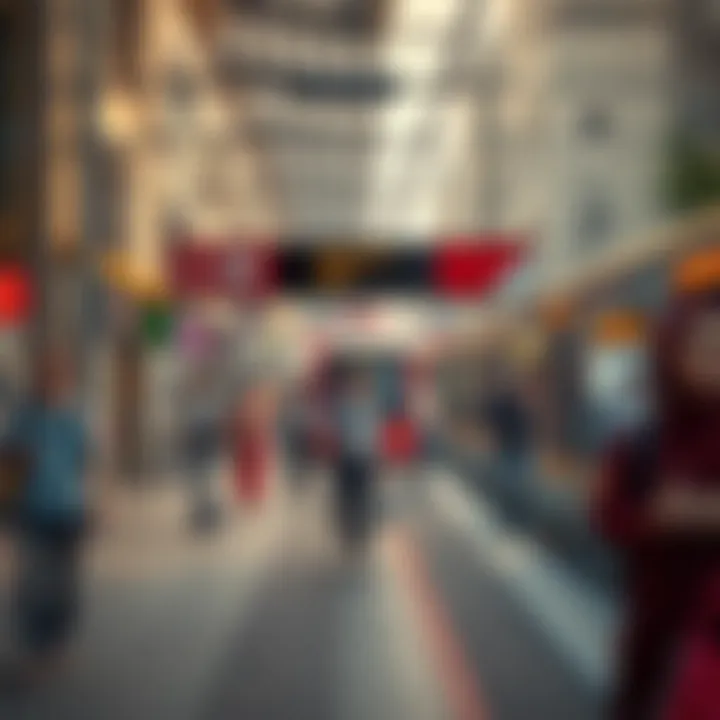
One of the most compelling aspects of the Red Line's impact is the consistent appreciation of property values in areas surrounding its stations. This type of infrastructural development often leads to a "metro effect," where proximity to rail stations can drive up real estate prices. For instance, properties close to the Burjuman Station have seen notable increases in value, as the location is considered prime due to its accessibility to both the commercial heart of the city and major tourist attractions.
Factors contributing to this appreciation include:
- Accessibility: Easy access to the metro allows residents to commute effortlessly, which raises demand for housing nearby.
- Urban Development: Areas around metro stations usually experience enhanced urban planning, leading to better infrastructure, parks, and public amenities.
- Demand Surges: Increased foot traffic from commuters often attracts businesses, leading to a burst in demand for residential and commercial spaces.
Understanding these trends can provide insights for investors looking to maximize their returns. As the Red Line expands or enhances its services, likely, property values in these hot spots will continue to rise.
Business Growth in Proximity
The economic revitalization of areas near Red Line stations is not merely about residential property. The business climate has similarly flourished. Businesses leverage the metro's extensive reach to tap into a larger customer base. For instance, cafes, retail stores, and service providers strategically establish themselves near stations to capitalize on commuter traffic, thus increasing their visibility and sales prospects.
Several observations regarding business growth include:
- Consumer Footfall: High volumes of daily commuters translate directly to increased patronage for local businesses, fostering a vibrant economic ecosystem.
- Investment Attraction: Areas adjacent to metro stations often draw investors seeking to establish retail or service ventures, raising competition and elevating service standards.
- Networking Opportunities: The convergence of businesses creates networking avenues that can foster partnerships, and new ventures often emerge from such collaborations.
To illustrate, you can see how businesses near the Mall of the Emirates Station fare compared to those in less accessible neighborhoods. Their success stories often create a ripple effect, encouraging new businesses to set up shop, boosting local economies further.
"The Red Line Metro is not just steel tracks and trains; it's a lifeline for economic prosperity in many neighborhoods across Dubai."
Ultimately, understanding these dynamics will enable better decision-making for those involved in real estate and business development. The interplay between transport infrastructure and economic growth represents a cornerstone for thriving urban centers like Dubai.
Environmental Considerations
The aspects of Environmental Considerations related to the Red Line Metro in Dubai are crucial, especially when discussing the future of urban transit and its impacts. Given the booming population and rapid urbanization of Dubai, understanding how the Metro has been designed to minimize the ecological footprint while enhancing urban mobility becomes essential. The Red Line, as part of Dubai's Vision 2021, contributes significantly to sustainable living by encouraging a shift away from fossil fuel dependence and personal vehicle use.
Sustainability Features
Sustainability Features embedded within the Red Line Metro system reflect a commitment to preserving the environment. The stations are constructed with energy-efficient materials and utilize advanced technologies, helping to decrease energy consumption. Here are some notable features:
- Solar Panels: Some stations are equipped with solar panels that harness sunlight to power lighting and electronic systems, reducing reliance on traditional power sources.
- Water Conservation: Rainwater harvesting systems are installed to manage runoff and minimize water waste.
- Recycled Materials: The use of recycled materials in construction not only reduces landfill waste but also cuts down on the demand for new resources.
- Green Space Integration: Landscaping around stations incorporates native plants, which require less water and adapt better to the local climate, thus promoting biodiversity.
As an investment, these features ensure that properties near these stations maintain a higher value due to the perceived sustainability and reduced environmental impact, making it attractive to eco-conscious buyers and investors alike.
Effect on Urban Mobility
The Effect on Urban Mobility cannot be understated. The Red Line Metro has redefined how residents and visitors navigate the city, offering an attractive alternative to cars. This shift has several impacts:
- Reduction in Traffic Congestion: With more commuters opting for public transport, the streets experience less traffic, resulting in faster travel times for everyone.
- Lower Carbon Emissions: The Metro's electric trains produce significantly lower emissions compared to conventional automobile travel. This shift contributes to improved air quality, particularly in a city known for its occasional dust storms and heat.
- Enhanced Connectivity: The Red Line connects key areas of Dubai, facilitating easier access to business districts, tourist attractions, and residential communities. Such connections foster economic growth and encourage local commerce.
Moreover, by expanding public transport options, the Red Line supports a shift in public perception regarding urban mobility, making commuting by train a viable choice for many individuals and families.
"An impressive element of the Red Line is its potential to influence urban growth patterns, steering development toward transportation corridors and fostering a more sustainable city layout."
In summary, the Red Line Metro in Dubai embodies a progressive approach to urban transit, balancing the growth demands of an expanding metropolis with essential environmental stewardship.
Future Developments for the Red Line
The future of the Red Line Metro in Dubai is a topic of considerable importance for a number of stakeholders, including investors, property developers, and commuters. Understanding the plans for extension and the technological innovations can provide critical insights into how the Red Line will adapt to the growing demands of the city and its residents. The expansion and enhancement of this transit system not only address current inefficiencies but also pave the way for sustainable urban growth.
Plans for Extension
The plans for extension of the Red Line are as ambitious as they are necessary. Current strategies aim to broaden the reach of the metro, connecting areas that are not served at present, which in turn encourages development in previously underutilized neighborhoods. Proposed extensions aim to include new stations that service regions like Dubai World Central and the Expo 2020 site, linking key hubs of activity.
Furthermore, these plans reflect a push towards integrating the metro with other forms of transportation, including buses and water taxis, creating a more cohesive public transport system. This makes commuting in Dubai a smoother experience, which critical for economic interactions among businesses.

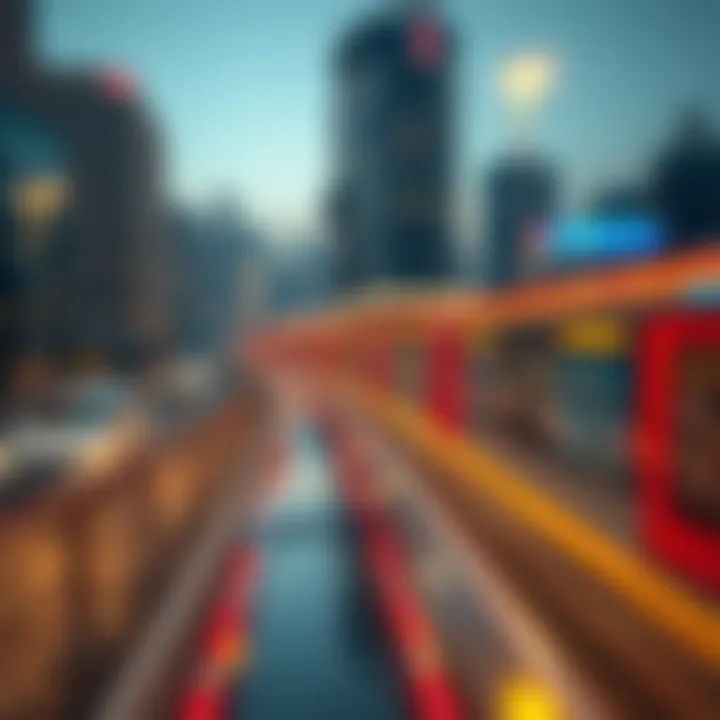
- Benefits of the Extension:
- Enhances ease of access to vital areas
- Spurs property development, boosting real estate values
- Reduces traffic congestion on major roadways
Quotes from city planners indicate that these extensions could drastically improve the quality of life for residents, providing faster travel times and better connectivity:
"An expanded metro system will be the lifeblood of our urban environment, fostering community growth and reducing our dependence on private vehicles."
Technological Innovations
Technological innovations related to the Red Line have the potential to reshape the commuting landscape dramatically. Investments in smart technology aim to elevate the user experience while also increasing the efficiency of the metro system. This includes enhanced signal systems and automated train operations designed to minimize delays and increase frequency—spinning the wheels of a more reliable transit system.
Some of the highlights of innovative implementations include:
- Real-time tracking systems: Providing commuters with mobile updates about train timings, allowing for more informed travel decisions.
- Energy-efficient trains: Newer models are being developed with sustainability in mind, which align with Dubai's broader environmental goals.
- Contactless payment solutions: These enable faster boarding times and minimize congestion at ticket booths, thus improving flow through stations.
Each of these advancements not only enhances the user experience but also positions the Red Line as a forward-thinking transit option in an era where cities must leverage technology to meet rising populations. Investors and developers closely monitor these technological shifts, as such efficiencies often lead to enhanced property values and economic opportunities surrounding the stations.
Given the path toward expansion and technological enhancement, the Red Line Metro in Dubai is poised to become more than just a transport system; it’s set to be a catalyst for urban renewal and an essential backbone of the city's overall infrastructure.
For more on the future developments of urban transport, you can check resources from Wikipedia or Britannica for more context on how international metro systems are progressing.
Public Perception and User Experience
Understanding public perception and user experience with the Red Line Metro system is crucial. These elements not only influence daily commuters but also shape the broader narrative surrounding urban transport in Dubai. The quality of service, efficiency, and convenience significantly reflect on how the metro system is viewed by residents and visitors alike. Positive commuter experiences can lead to increased ridership and better community engagement, while negative perceptions may hold the potential to dampen public support and future investments.
Commuter Feedback
Commuter feedback plays a vital role in enhancing services and addressing concerns within the Red Line network. Users express their thoughts through various forums, from social media platforms like Facebook to feedback sections on official transport websites like RTA. This direct communication channel gives an insight into what riders truly think, allowing for improvements based on real experiences.
Some common points of feedback include:
- Cleanliness of the stations and trains: A well-maintained environment contributes greatly to the comfort of users. Many commuters have highlighted the need for regular cleaning schedules to keep stations and trains in top shape, which further enhances the riding experience.
- Train frequency and waiting times: Riders often discuss their concerns regarding overcrowding during peak hours or the frequency of trains. Smoother operations during rush hours may encourage more people to ditch personal vehicles for public transport, as it presents a quick alternative.
- Safety and security: The perception of safety is paramount for commuters. The presence of surveillance cameras and trained staff, along with visible security protocols, significantly impacts how comfortable people feel using the metro. Positive feedback in this area can lead to increased utilization and trust in the system.
Comparative Analysis with Other Metro Systems
When comparing the Red Line Metro to other metro systems worldwide, it stands out in several respects, but also has areas for improvement. Taking a closer look at global counterparts, such as the London Underground or New York City Subway, we can identify patterns that differentiate user experiences.
- Efficiency and Punctuality: The Red Line has made commendable strides in maintaining punctual services, a metric often highlighted by users. Riders appreciate timely departures and arrivals. In contrast, some older systems face delays due to infrastructure issues.
- Technology Integration: The integration of digital technology within the Red Line stations offers a seamless commutation experience. Informational displays regarding train arrival and service updates are frequent. This technology-driven approach can sometimes be more advanced compared to others, which might still rely on manual announcements, complicating the user journey.
- Coverage and Accessibility: While the Red Line provides essential connectivity across Dubai, its extent and coverage still require further expansion to reach outlying neighborhoods. Other metro systems may have wider coverage, making them more convenient for commuters who live farther from urban hubs.
In summary, the public perception of the Red Line Metro is a dynamic interplay of commuter feedback and comparative analysis with other transit systems. Positive experiences can foster loyalty and increased ridership, while areas needing improvement can lead to public discontent. Effectively addressing these elements can ensure that the Red Line continues to thrive and meet the expectations of its users.
Epilogue
The conclusion of this exploration into the Red Line Metro Stations in Dubai encapsulates the multifaceted significance of this transit system. As urban transport becomes more vital in today’s world, the Red Line stands out not just as a means of commutation, but also as a catalyst for development and a beacon for investment opportunities. The implications of the Red Line stretch far beyond simplistic travel; they weave into the very fabric of urban planning, real estate trends, and the cultural renaissance of Dubai.
Summary of Key Points
To encapsulate what has been discussed, here are the pivotal elements surrounding the Red Line:
- History and Development: From its initiation to operational status, the Red Line's growth reflects Dubai's transformation into a global city.
- Architectural Design: Each station's unique design adds to the aesthetic appeal of the urban landscape while catering to functionality and accessibility.
- Economic Influence: The rise in property values and business opportunities in close proximity to stations illustrates the Red Line’s significant economic impact.
- Environmental Considerations: The design promotes sustainability and has begun to reshape urban mobility within the city.
- Cultural Contributions: The integration of art and community involvement enriches the commuter experience, making each journey notable.
This complex interrelationship between transit, urban development, and community experience showcases the depth of the Red Line's existence within Dubai.
Implications for Real Estate Investors
Understanding the intertwined nature of the Red Line and the real estate market is vital for investors and stakeholders. Here are key factors to deliberate:
- Location Advantage: Properties near metro stations often appreciate faster. Proximity to the Red Line enhances desirability and boosts rental potential.
- Market Trends: Awareness of how transit developments influence buyer preferences can aid investors in aligning their strategies to emerging trends.
- Infrastructure Growth: New station constructions or expansions can lead to infrastructural upgrades in surrounding areas, facilitating future growth.
- Urban Planning and Collaborations: Investors should collaborate with urban planners to anticipate changes and leverage upcoming projects tied to transit developments.
"The Red Line is not merely a transport system; it is an investment vector poised to shape the future of Dubai's urban landscape."
In summary, delving into the operational mechanics and impacts of the Red Line Metro reveals a wealth of opportunities for investors. The ability to discern how these elements interplay can dictate long-term strategies in real estate, ensuring lucrative decisions lie just around the corner. With the right insight, the connection between the metro’s evolution and the property market can yield substantial rewards.







